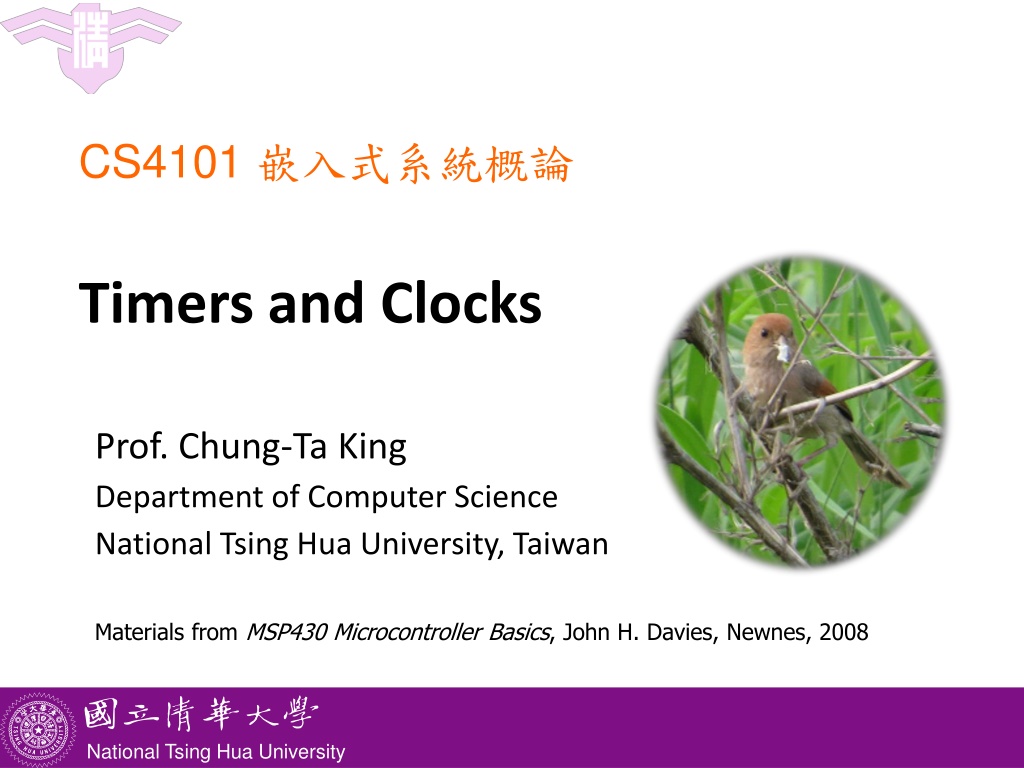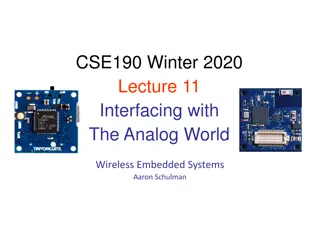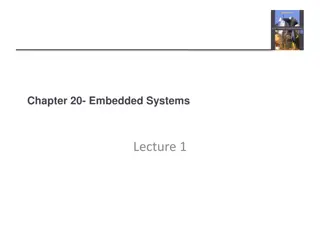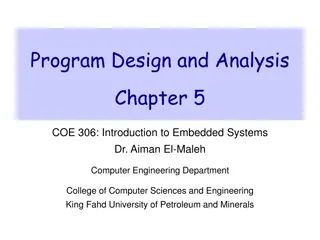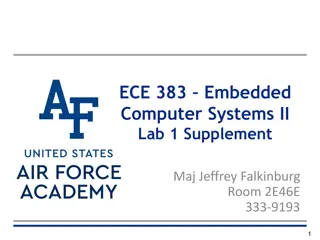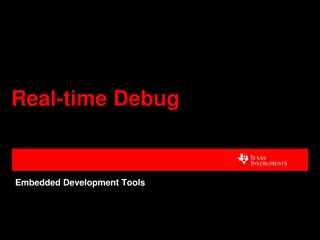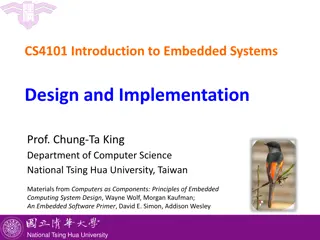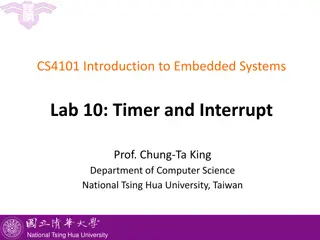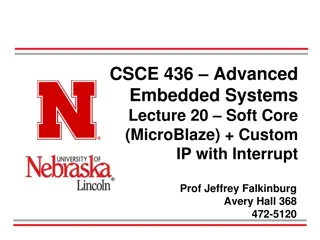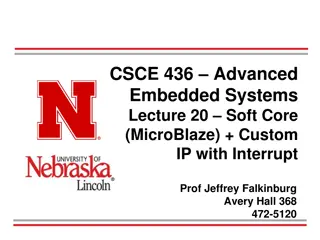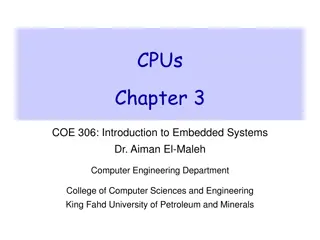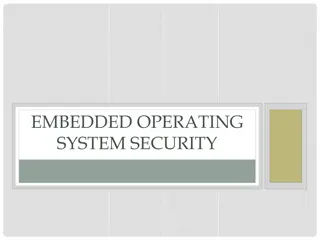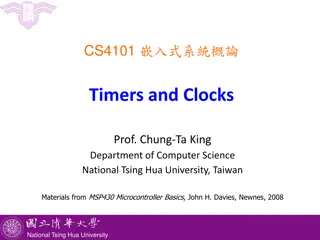Understanding Time Management in Embedded Systems
Explore the significance of time monitoring in embedded systems through examples like container thermometers and real-time applications. Learn about managing time-based controls, challenges with software delay loops, and the importance of hardware timers for accurate time tracking.
Download Presentation

Please find below an Image/Link to download the presentation.
The content on the website is provided AS IS for your information and personal use only. It may not be sold, licensed, or shared on other websites without obtaining consent from the author. Download presentation by click this link. If you encounter any issues during the download, it is possible that the publisher has removed the file from their server.
E N D
Presentation Transcript
CS4101 Timers and Clocks Prof. Chung-Ta King Department of Computer Science National Tsing Hua University, Taiwan Materials from MSP430 Microcontroller Basics, John H. Davies, Newnes, 2008 National Tsing Hua University
Recall the Container Thermometer Container thermometer: monitor the temperature of the interior of a container Monitor the temperature every 5 minutes Flash LED alarm at 1 Hz If the temperature rises above a threshold, flash the LED alarm at 3 Hz and notify backend server If the temperature drops below a threshold, return the LED alarm to normal and notify the server Need to know exact time! 1 National Tsing Hua University
Time-based Control Many embedded systems are used to control things based on time or that have time constraints Traffic light controller Power meter Pacemaker ( ) Subway collision avoidance system Airbag ... How to track real (wall clock) time? 2 National Tsing Hua University
Recall First MSP430 Program #include <msp430x2553.h> void main(void) { WDTCTL = WDTPW + WDTHOLD; // Stop watchdog timer P1DIR |= 0x41; // set P1.0 & 6 to outputs //(red & green LEDs) for(;;) { volatile unsigned int i; P1OUT ^= 0x41; // Toggle P1.0 & 6 using XOR i = 50000; // Delay do (i--); while (i != 0); } } How much time? 3 National Tsing Hua University
Problems Regarding Time Using software delay loops Waste of processor because it is not available for other operations Difficult to translate into actual time Given a time for the delay, difficult to translate into number of iterations The delays are unpredictable, e.g., compiler optimization, interrupts We need an independent reference of time! 4 National Tsing Hua University
Reference of Time The simplest hardware to provide a reference of time is a counter that counts every fixed unit of time timer Clock Counter The actual time can be obtained by multiplying the counter with the clock interval time The accuracy and stability of the clock is critical Where to put the timers? 5 National Tsing Hua University
Make Timer an IO Device! 6 National Tsing Hua University
Timers Being IO Devices Have internal registers with addresses in the memory space for the CPU to access 7 National Tsing Hua University
Typical Registers in a Timer The counter itself Target for counting Control settings Others: clock source selection, flags Counter Comparator Control Target Time 8 National Tsing Hua University
Outline Basic concepts of timers MSP430 timers An example of using MSP430 Timer_A Clocks in MSP430 9 National Tsing Hua University
MSP430 Timers Contain several timers, including: Timer_A/Timer_B: A 16-bit counter, TAR, with 3 capture/compare registers MSP430G2553 has two instances of Timer_A : Timer0_A3 and Timer1_A3 Watchdog timer: Count up and reset MSP430 when it reaches its limit The code must keep clearing the counter before the limit is reached to prevent a reset Protect system against failure of software, such as unintended, infinite loops 10 National Tsing Hua University
Registers in Timer_A TAR (0170h): the counter itself TACCR0 (0172h): target for counting TACTL (0160h): control settings Others: clock source selection, flags TACCR0: capture/compare registers In MSP430G2553, they are called TA0R/TA1R, TA0CCR0/TA1CCR0, TA0CCR1/TA1CCR1, TA0CCR2/TA1CCR2, TA0CTL/TA1CTL 11 National Tsing Hua University
Inside Timer_A Timer_A Control Register: TACTL (0160h) 12 National Tsing Hua University
Typical Operations of Timer_A Continuously count up/down Yes TACTL Is time up yet? TAIFG has to be explicitly cleared by the CPU TACCRx If TAIE=1, setting of TAIFG causes an interrupt to the CPU (x may be 0, 1, or 2) 13 National Tsing Hua University
Timer_A Control Register (TACTL) TASSELx: Timer_A clock source select (x is 0, 1, 2, or 3) IDx: input divider MCx: mode control TACLR: Timer_A clear TAIE: Timer_A interrupt enable TAIFG: Timer_A interrupt flag 14 National Tsing Hua University
TACTL (TA0CTL/TA1CTL) TA0CTL = TASSEL_2 + MC_1; // src from SMCLK, up mode 15 National Tsing Hua University
Timer Mode MCx=00: Stop mode The timer is halted MCx=01: Up mode The timer repeatedly counts from 0 to TA0CCR0 MCx=10: Continuous mode The timer repeatedly counts from 0 to 0FFFFh MCx=11: Up/down mode The timer repeatedly counts from 0 to TA0CCR0 and back down to 0 16 National Tsing Hua University
Up Mode The up mode is used if the timer period must be different from 0FFFFh counts. 1. Timer period 100 store 99 to TA0CCR0 2. When TA0CCR0 == 99, set TA0CCR0 CCIFG flag (discussed later) 3. Reset timer to 0 and set TAIFG interrupt flag TAIFG is set, and Timer0_A3 interrupts CPU 17 National Tsing Hua University
Continuous Mode In the continuous mode, the timer repeatedly counts up to 0FFFFh and restarts from zero The TAIFG interrupt flag is set when the timer resets from 0FFFFh to zero 18 National Tsing Hua University
Up/Down Mode The up/down mode is used if the timer period must be different from 0FFFFh counts, and if a symmetrical pulse generation is needed. The period is twice the value in TA0CCR0 Timer interrupts! (TAIFG is set) 19 National Tsing Hua University
Timer_A Capture/Compare Block Timer Block May contain several Capture/Compare Blocks (MSP430G2553 has 3 blocks for each of the 2 timers) Each Capture/Compare Block is controlled by a control register, TACCTLx Inside each Capture/Compare Block, the Capture/Compare Register, TACCRx, holds the count to configure the timer Capture/Compare Block 20 National Tsing Hua University
Modes of Capture/Compare Block Compare mode: (CAP = 0) Compare the value of TAR with the value stored in TACCRn and update an output when they match Capture mode: (CAP = 1) Used to record time events records the time (value in TAR) at which the input changes in TACCRx The input, usually CCIxA and CCIxB, can be either external or internal from another peripheral or software, depending on board connections TA0CCR0 = 24000; // represent 2 sec with 12kHz clk src (12 kHz = 12,000 counts/sec 24,000 counts = 2 sec.) 21 National Tsing Hua University
TACCTL (Capture/Compare Control Reg.) 22 National Tsing Hua University
TACCTL contd 23 National Tsing Hua University
Sample Code 1 for Timer_A Goal: simplest way to flash an LED at 1 Hz Need an event to trigger the flashing counter (TAR) overflow Need a way to detect the event CPU polling How to make TAR overflow at 1 Hz? Use SMCLK clock (discussed later) at 800 KHz When TAR (16 bits) overflows, it has counted 216, equivalent to a period of 216/800KHz 0.08 sec Divide the frequency of the clock by 8 to give a period of about 0.66 sec close enough! Continuously count up; on overflow return to 0 24 National Tsing Hua University
Sample Code 1 for Timer_A #define LED1 BIT0 void main(void) { WDTCTL = WDTPW|WDTHOLD; // Stop watchdog timer P1OUT = ~LED1; P1DIR = LED1; TA0CTL = MC_2|ID_3|TASSEL_2|TACLR; //Setup Timer_A for (;;) { // Loop forever while (TA0CTL_bit.TAIFG == 0) { // Wait overflow } // CPU polling and doing nothing TA0CTL_bit.TAIFG = 0; // Clear overflow flag P1OUT = LED1; // Toggle LEDs } // Back around infinite loop } 25 National Tsing Hua University
Sample Code Settings Explained The following symbols are defined in header file: MC_2: set MC of TA0CTL to 102 (continuous mode) ID_3: set ID of TA0CTL to 112 (divide freq. by 8) TASSEL_2: set TASSEL to 10 (use SMCLK) TACLR: clear the counter, the divider, and the direction of the count 26 National Tsing Hua University
Sample Code 2 for Timer_A Can have more accurate time if we can control the amount to count The maximum desired value of the count is programmed into TA0CCR0 TA0R starts from 0 and counts up to the value in TA0CCR0, after which it returns to 0 and sets TAIFG Thus the period is TA0CCR0+1 counts With SMCLK (800KHz) divided down to 100 KHz, we need 50,000 counts for a delay of 0.5 sec store 49,999 in TA0CCR0 27 National Tsing Hua University
Outline Basic concepts of timers MSP430 timers An example of using MSP430 Timer_A Clocks in MSP430 28 National Tsing Hua University
Theoretically, One Clock Is Enough A clock is a square wave signal whose edges trigger hardware A clock source, e.g. crystal, to drive CPU directly, which is divided down by a factor of 2 or 4 for the main bus and rest of circuit board But, systems have conflicting requirements Low power, fast start/stop, accuracy, ... 29 National Tsing Hua University
Different Requirements for Clocks Devices often in a low-power mode until some event occurs, then must wake up and handle event rapidly Clock must get to be stabilized quickly Devices also need to track real time: (1) can wake up periodically, or (2) time-stamp external events Therefore, two kinds of clocks often needed: A fast clock to drive CPU, which can be started and stopped rapidly but need not be particularly accurate A slow clock that runs continuously to monitor real time, which must use little power and be accurate 30 National Tsing Hua University
Different Requirements for Clocks Different clock sources also have different characteristics Crystal: accurate and stable (w.r.t. temperature or time); expensive, delicate, drawing large current, external component, longer time to start up/stabilize Resistor and capacitor (RC): cheap, quick to start, integrated within microcontroller and sleep with CPU; poor accuracy and stability Ceramic resonator and MEMS clocks in between Need multiple clocks 31 National Tsing Hua University
Clocks in MSP430 MSP430 addresses the conflicting demands for high performance, low power, precise frequency by using 3 internal clocks, which can be derived from up to 4 sources Master clock (MCLK): for CPU and some peripherals, normally driven by digitally controlled oscillator (DCO) Subsystem master clock (SMCLK): distributed to peripherals, normally driven by DCO Auxiliary clock (ACLK): distributed to peripherals, normally for real-time clocking, normally driven by a low-frequency crystal oscillator, typically at 32 KHz 32 National Tsing Hua University
Clock Sources Low- or high-frequency crystal oscillator, LFXT1: External; used with a low- or high-frequency crystal; an external clock signal can also be used; connected to MSP430 through XIN and XOUT pins High-frequency crystal oscillator, XT2: External; similar to LFXT1 but at high frequencies Very low-power, low-frequency oscillator, VLO: Internal at 12 KHz; alternative to LFXT1 when accuracy of a crystal is not needed; may not available in all devices Digitally controlled oscillator, DCO: Internal; a highly controllable RC oscillator that starts fast 33 National Tsing Hua University
From Sources to Clocks Typical sources of clocks: MCLK, SMCLK: DCO (typically at 1.1 MHz) ACLK: LFXT 1 (typically at 32 KHz) Note: Interconnections may vary with different MCUs 34 National Tsing Hua University
MSP430 Clock System 35 National Tsing Hua University
Controlling Clocks In MSP430, the Basic Clock Module is also an IO peripheral Being an IO peripheral, it can be controlled by registers, DCOCTL and BCSCTL1 3 DCOCTL (056h): configure DCO BCSCTL1 (basic clock system control 1, 057h): configure ACLK BCSCTL2 (basic clock system control 2, 058h): configure MCLK, SMCLK BCSCTL3 (basic clock system control 3, 053h): control LFXT1/VLO 36 National Tsing Hua University
Control Registers for Clocks Control Registers for Clock System DCOCTL and BCSCTL1 combined define the frequency of DCO, among other settings 37 National Tsing Hua University
DCOCTL (at Memory Address 056h) Tag-Length-Value DCOCTL = CALDCO_1MHZ; // Set DCO step + modulation 38 National Tsing Hua University
Tag-Length-Value Tag-Length-Value (TLV) stores device-specific information in the flash memory to set DCOCTL and BCSCTL1 for DCO frequency BCSCTL1 = CALBC1_1MHZ; DCOCTL = CALDCO_1MHZ; // Set range 39 National Tsing Hua University
MSP430G2553 Memory Map Flash/ROM (16 KB) Flash/ROM (256 bytes) Information memory: A 256B block of flash memory that stores nonvolatile data, including serial numbers to identify the equipment RAM (512 bytes) 40 National Tsing Hua University
BCSCTL1 BCSCTL1 = CALBC1_1MHZ; // Set range 41 National Tsing Hua University
BCSCTL2 MCLK SMCLK BCSCTL2 |= SELM_3 + DIVM_3; // MCLK = VLO/8 42 National Tsing Hua University
BCSCTL3 BCSCTL3 |= LFXT1S_2; // Enable VLO as MCLK/ACLK src 43 National Tsing Hua University
Interrupt Flag Register 1 (IFG1) OFIFG oscillator-fault flag is set when an oscillator fault (LFXT1OF) is detected. IFG1 &= ~OFIFG; // Clear OSCFault flag 44 National Tsing Hua University
Sample Code 2 for Timer_A Flash red LED at 1 Hz using SMCLK at 800 KHz #include <msp430.h> #define LED1 BIT0 void main (void) { WDTCTL = WDTPW|WDTHOLD; // Stop watchdog timer P1OUT = ~LED1; P1DIR = LED1; TA0CCR0 = 49999; TA0CTL = MC_1|ID_3|TASSEL_2|TACLR; //Setup Timer0_A //up mode, divide clk by 8, use SMCLK, clr timer for (;;) { // Loop forever while (!(TA0CTL & TAIFG)) {) // Wait for time up TA0CTL &= ~TAIFG; // Clear overflow flag P1OUT ^= LED1; // Toggle LEDs } // Back around infinite loop } 45 National Tsing Hua University
Sample Code for Setting Clocks Set DCO to 1MHz, enable crystal #include <msp430.h> void main(void) { WDTCTL = WDTPW + WDTHOLD; // Stop watchdog timer if (CALBC1_1MHZ == 0xFF || CALDCO_1MHZ == 0xFF) while(1); // If TLV erased, TRAP! BCSCTL1 = CALBC1_1MHZ; DCOCTL = CALDCO_1MHZ; P1DIR = 0x41; // P1.0 & 6 outputs (red/green LEDs) P1OUT = 0x01; // red LED on BCSCTL3 |= LFXT1S_0; // Enable 32768 crystal IFG1 &= ~OFIFG;// Clear OSCFault flag P1OUT = 0; // red LED off BCSCTL2 |= SELS_0 + DIVS_3; // SMCLK = DCO/8 // infinite loop to flash LEDs } // Set range 46 National Tsing Hua University
